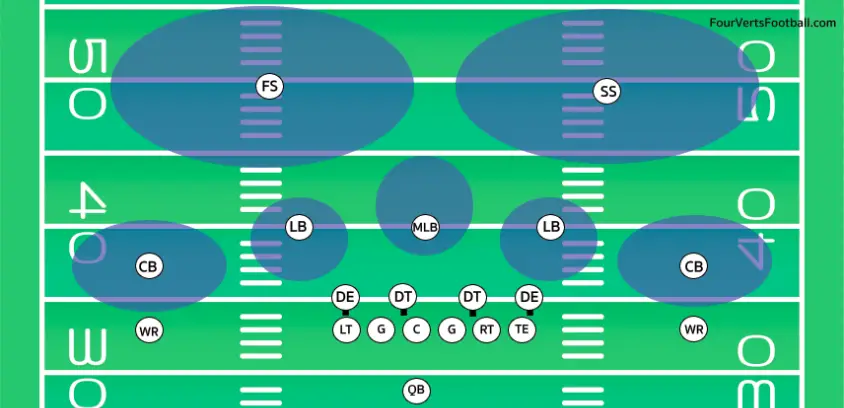Man to Man and zone coverage are the two prevailing methods used to stop the opposing team from passing the football.
Man to man coverage consists of matching defenders with specific receivers and following them around the field throughout the play.
Zone coverage assigns portions of the field to each defender. Each defender is then responsible for stopping any passes from being completed in their area.
Both of these defensive coverage styles have advantages and disadvantages. Oftentimes teams will use a combination of man and zone coverage in order to stop the opposing team’s passing attack.

Pros And Cons Of Man Coverage
Pros
No Holes In The Coverage
One of the biggest benefits of man to man coverage is that there is not going to be any obvious holes.
In order for the opposing team’s receivers to get open, they are going to have to beat one of your defenders man to man.
In zone coverage, there will be certain portions of the field which the zones do not reach. This allows the offense to beat the defense without beating the players individually.
Choosing Your Matchups
Another benefit of man coverage is that you are able to pick your matchups. If you have an incredibly skilled corner you can put him in man coverage against the top receiver on the opposing team.
This is called shadowing and allows your top defensive players to focus in on the opposing team’s top weapons.
When playing zone defense you may find the offense will move receivers into zones with weaker defensive players.
This allows the offense to take advantage of the matchup.
Cons
Getting Beat Over The Top
Playing man on man coverage can sometimes leave a defense more susceptible to plays over the top. when covering one on one receivers have a much better chance at beating a defender on a deep pass.
This can allow for some big plays to happen from the offense. Zone defenses typically have players in a deep zone waiting to stop these sorts of throws.
Pick Plays
One more negative aspect of man coverage in football is the use of pick plays by the offense.
A pick play in football occurs when an offensive player intentionally gets into the way of a defender covering a receiver.
Typically this is done by running two wide receiver routes right by one another. When the players cross each others paths the defenders must follow.
Ideally one of the receivers is going to get in a defender’s way resulting in a receiver being wide open.
On these plays, the receiver must be sure not to intentionally contact the defender or a penalty will be called. But if the receiver is simply running his route and the defender must go around him this is a legal pick play.
This sort of play cannot be used nearly effectively against zone coverage as these players will not be following a receiver around the field.
Pros And Cons Of Zone Coverage
You Don’t Need To Match Their Talent
One of the biggest positives of zone coverage is that you do not need your players to match the talent level of the opposing wide receivers.
When playing man coverage you are going to need your cornerbacks to keep up with the opposing team’s top receivers. When playing zone you can rely on the scheme of your zone to stop the opponent’s passing attack.
In a zone defense defenders will only have to run with receivers for short periods of time. If they are beaten badly it is likely that another zone defender will pick up that receiver as he moves throughout the field.
This is especially helpful when facing teams with an elite receiving core. Or if you are running a defense that has below average talent when it comes to pass coverage.
Confusing The Offense
Another benefit of the zone defense is that it can offer a lot more looks for the quarterback. When playing man coverage the quarterback is going to have an easy read on the defense.
This is because he knows each defender is going to follow his man throughout the play. A zone defense can offer many different looks which ultimately can confuse the quarterback.
By changing the location and personnel of your zone coverage you will make the quarterback’s job a lot harder. And ultimately you may be able to force a bad throw into an area covered by the zone defense.
Cons
Holes In The Defence
The biggest con of the zone defense is that it is always going to have holes somewhere on the field. If you are facing an elite quarterback he may be able to consistently find the holes in between zones in your defense.
If a quarterback is able to consistently find these holes then the zone defense will be unsuccessful. This is why you will often see experienced quarterbacks pick apart a zone defense at the NFL level.
Offense dictates the matchup
Another negative aspect of zone coverage is that the offense is often going to dictate the matchup.
As we covered earlier in the article it is common for defenders to shadow wide receivers and follow them around the field.
In a zone defense this isn’t going to be the case. This means the offense may move their receivers around in order to generate a more favourable matchup.
This can result in mismatches which can be difficult for the defense to stop.
Conclusion
I hope you enjoyed this guide on the differences between man to man vs zone defense.
Remember man to man involves each defender covering a specific player while zone coverage consists of covering a specific location on the field.
If you want to learn more about football we have plenty of other articles you may find interesting. Check out our guides to understanding the press coverage strategy used by cornerbacks or what a cover 2 defense is.

